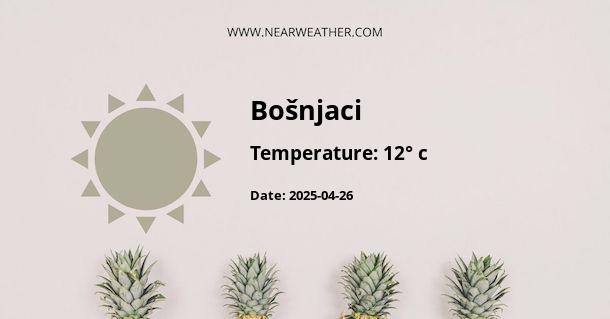Understanding the Climate and Weather Patterns of Bosnjaci, Croatia
The picturesque village of Bosnjaci is situated in the eastern part of Croatia, within the Vukovar-Srijem County. It is a place with a rich history and serene landscape that appeals to travelers and residents alike. One of the critical aspects influencing the everyday life and economy of Bosnjaci is its continental climate. Here, we delve deep into the various weather factors that affect the region, providing comprehensive insights tailored for weather enthusiasts, travelers planning a visit, and the local populace interested in understanding their environment better.
The Continental Climate of Bosnjaci Defined
Croatia's climate varies from continental in the interior regions to Mediterranean along the Adriatic coast. Bosnjaci, which lies in the interior part, experiences a Humid Continental climate (Dfb) according to the Köppen climate classification. This means that the region undergoes warm summers and cold winters, with a distinct temperature difference between these two seasons.
Let's break down the climate characteristics of Bosnjaci month by month and delve into the specifics to comprehend its weather pattern better.
January – The Coldest Month
- Mean temperature often hovers around -1°C (30°F).
- Heavy snowfall is common, with snow cover persisting for several days or even weeks.
February – The Waning of Winter
- Temperatures start to rise slowly, averaging around 1°C (34°F), with melting snow starting to be a common sight.
March – The Arrival of Spring
- Temperatures climb higher, averaging 6°C (43°F).
- There's an increase in precipitation with frequent rain.
April – A Notable Transition
- Average temperatures reach 11°C (52°F).
- Plant life begins to bloom, and the countryside becomes greener.
May – The Warm-Up
- A significant increase to an average of 16°C (61°F).
- Rainfall continues, contributing to lush landscapes.
June – The Start of Summer
- Temperatures now often rise to 20°C (68°F).
- Longer days and short nights characterize this period.
July – The Peak of Summer
- This month typically sees the highest temperatures, averaging around 22°C (72°F).
- Heatwaves can push temperatures significantly higher.
August – Continuation of Warmth
- Very similar to July, with little variation in temperature.
September – The Beginnings of Autumn
- A cooler climate sets in, with averages falling to around 17°C (63°F).
- Precipitation increases again as the month progresses.
October – The Heart of Autumn
- Temperatures continue to drop, reaching averages around 11°C (52°F).
- Harvesting happens around this time, with the weather influencing agricultural activities.
November – The Onset of Winter
- A noticeable drop in temperatures averaging 5°C (41°F), with early snowfalls possible.
December – The Deepening of Winter
- Temperatures often drop below freezing, averaging around 0°C (32°F).
- Snowfalls become more frequent, spreading a festive atmosphere.
Precipitation Patterns
The continental climate of Bosnjaci brings with it a fair distribution of rainfall throughout the year. However, precipitation peaks occur generally in the late spring and early autumn months.
Wind and Other Climatic Factors
Wind patterns in Bosnjaci do not typically feature the strong coastal winds known in the Mediterranean region of Croatia. Instead, the region experiences gentler, although sometimes unpredictable, winds that can influence day-to-day weather.
Extreme Weather Conditions and Climate Change
Bosnjaci, like many parts of the world, is not immune to the effects of climate change. Shifts in long-term weather patterns could potentially alter the traditional climate dynamics, including the frequency and intensity of extreme weather events such as heatwaves, storms, and heavy snowfalls.
Annual Weather Statistics
A look at the key annual weather statistics for Bosnjaci includes:
| Parameter | Value |
|---|---|
| Average High (°C) | 14 |
| Average Low (°C) | 5 |
| Annual Precipitation (mm) | 680 |
| Snowfall days | 30 |
Climate Considerations for Visitors and Residents
Understanding the climate is not only beneficial for those looking to visit Bosnjaci but also for residents and industries that depend on weather patterns. Agriculture, for instance, depends heavily on the predictability and understanding of seasonal variations. Tourists who seek to explore the beautiful landscapes of Bosnjaci would enjoy knowing the best time to visit, which is typically between late May and early September when the weather is warm and hospitable for outdoor activities.
Conclusion
The weather and climate of Bosnjaci are hallmarks of a beautifully varied continental system, embodying warmth in the summer and crispness during the winter months. Whether for planning agricultural pursuits, scheduling travel plans, or simply gaining an appreciation for the place, an in-depth understanding of Bosnjaci's climate dynamics is essential and fascinating.
A - Bošnjaci's Latitude is 45.050282 & Longitude is 18.755560.
A - Weather in Bošnjaci is 12° today.
A - Climate Conditions in Bošnjaci shows moderate rain today.
A - Humidity in Bošnjaci is 94% today.
A - Wind speed in Bošnjaci is 12.67 km/h, flowing at 281° wind direction. today.
